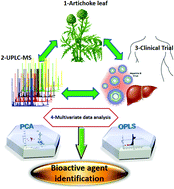The wild Egyptian artichoke as a promising functional food for the treatment of hepatitis C virus as revealed via UPLC-MS and clinical trials
Abstract
Infection by hepatitis C virus (HCV) and its subsequent complications are a major cause of mortality worldwide. The water extract of the wild Egyptian artichoke (WEA) (Cynara cardunculus L. var. sylvestris (Lam.) Fiori) leaves is a freely available herbal product that is used for treatment of HCV-infection complications such as jaundice and ascites. The purpose of this study was to evaluate whether WEA exhibits activity against HCV, identify bioactive chemicals in its extract and to tentatively examine the potential inhibitory interactions of WEA with human drug-metabolizing enzymes. The current pilot clinical trial revealed that the water extract of a WEA plant decreased the HCV viral load below the detection level in 12 out of 15 patients. Furthermore, the liver enzymes ALT and AST, as well as the level of bilirubin were normalized. The total WEA extract inhibited CYP2B6 (OH-BUP) and CYP2C19 (5-OH-OME) with high affinity, IC50 ∼ 20 μg ml−1, while moderate inhibitory interactions were observed for CYP1A2, CYP2D6, CYP2E1 and CYP3A4. Results presented herein suggest that the WEA exhibits strong antiviral activity against HCV and may be useful for its treatment. Compared to the artichoke product “Hepar SL Forte®”, WEA was found to be more enriched in sesquiterpenes versus the abundance of phenolic compounds, especially flavonoids in Hepar SL Forte® as revealed via UPLC-MS analysis coupled to chemometrics.


 Please wait while we load your content...
Please wait while we load your content...